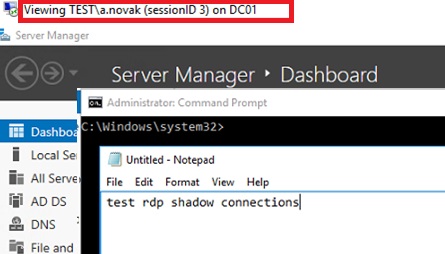
 If you use SL1 to monitor Hyper-V Servers, you must configure the user account for remote PowerShell access to the Hyper-V Servers. If you use SL1 to monitor Microsoft Exchange Servers, you must configure the user account for remote PowerShell access to Microsoft Exchange Server. On Windows Domain Controller servers, you can use a domain account that is not in the Domain Administrators group by following the configuration instructions for Option 3: Creating a Non-Administrator User Account.Īfter creating your Active Directory account: For instructions, consult Microsoft's documentation. Option 1: Creating an Active Directory Accountįor each Windows server that you want to monitor with PowerShell or WinRM, you can create an Active Directory account that is a member of the local Administrators group on each server. Option 3: Create a non-administrator user accountįor ease-of-configuration, ScienceLogic recommends creating an Active Directory user account.Īfter creating your Windows Server user account, depending on your setup and the servers you want to monitor, you might also need to configure the user account for remote PowerShell access to the following server types:. Option 2: Create a local user account with Administrator access.
If you use SL1 to monitor Hyper-V Servers, you must configure the user account for remote PowerShell access to the Hyper-V Servers. If you use SL1 to monitor Microsoft Exchange Servers, you must configure the user account for remote PowerShell access to Microsoft Exchange Server. On Windows Domain Controller servers, you can use a domain account that is not in the Domain Administrators group by following the configuration instructions for Option 3: Creating a Non-Administrator User Account.Īfter creating your Active Directory account: For instructions, consult Microsoft's documentation. Option 1: Creating an Active Directory Accountįor each Windows server that you want to monitor with PowerShell or WinRM, you can create an Active Directory account that is a member of the local Administrators group on each server. Option 3: Create a non-administrator user accountįor ease-of-configuration, ScienceLogic recommends creating an Active Directory user account.Īfter creating your Windows Server user account, depending on your setup and the servers you want to monitor, you might also need to configure the user account for remote PowerShell access to the following server types:. Option 2: Create a local user account with Administrator access.  Option 1: Create an Active Directory Account with Administrator access. To configure the Windows Server user account that SL1 can use to make PowerShell requests, complete one of the following options: You will include this user account information when creating the PowerShell credential that SL1 uses to collect data from the Windows Server. To enable SL1 to monitor Windows servers, you must first configure a user account on a Windows Server that SL1 can use to make PowerShell requests. Step 1: Configuring the User Account for SL1 Optionally, you can increase the number of PowerShell Dynamic Applications that can run simultaneously against a single Windows server. If you are configuring multiple Windows servers for monitoring by SL1, you can apply these settings using a Group Policy. Optionally, configure a Windows server as a Windows Management Proxy. Configure a Server Authentication Certificate to encrypt communication between SL1 and the Windows Server. The user account can either be a local account or an Active Directory account.įor ease of configuration, ScienceLogic recommends using an Active Directory account that is a member of the local Administrators group on the Windows Server.
Option 1: Create an Active Directory Account with Administrator access. To configure the Windows Server user account that SL1 can use to make PowerShell requests, complete one of the following options: You will include this user account information when creating the PowerShell credential that SL1 uses to collect data from the Windows Server. To enable SL1 to monitor Windows servers, you must first configure a user account on a Windows Server that SL1 can use to make PowerShell requests. Step 1: Configuring the User Account for SL1 Optionally, you can increase the number of PowerShell Dynamic Applications that can run simultaneously against a single Windows server. If you are configuring multiple Windows servers for monitoring by SL1, you can apply these settings using a Group Policy. Optionally, configure a Windows server as a Windows Management Proxy. Configure a Server Authentication Certificate to encrypt communication between SL1 and the Windows Server. The user account can either be a local account or an Active Directory account.įor ease of configuration, ScienceLogic recommends using an Active Directory account that is a member of the local Administrators group on the Windows Server.  Configure a user account that SL1 will use to connect to the Windows Server. To do so, you must perform the following general steps:
Configure a user account that SL1 will use to connect to the Windows Server. To do so, you must perform the following general steps: 
To monitor a Windows Server using PowerShell Dynamic Applications, you must configure the Windows Server to allow remote access from SL1.












